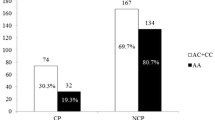Abstract
Recurrent pregnancy loss (RPL) is a problem affecting up to 5% of women of childbearing age due to many factors. Studies have shown that RPL and cardiovascular disease (CVD) may have shared risk factors. We compared the prevalence of 12 cardiovascular disease related gene mutations in patients with a history of RPL to normal controls in a major tertiary care center in Lebanon. The CVD StripAssay (ViennaLab, Austria) was used to analyze the CVD genes on 70 women with RPL history as part of the initial routine workup for recurrent miscarriage at the American University of Beirut Medical Center. The obtained results were compared with data of controls from the Lebanese population using Fisher’s exact test and Chi square analysis. Two genes of the CVD panel demonstrated a strong relationship with RPL, including, MTHFR (C677T homozygosity, A1298C homozygosity, and compound heterozygosity for C677T and A1298C) and Factor II (heterozygosity for G20210A). Moreover, a protective role of positive APO-E3 isoform was observed. This study is the first in the Lebanese population in associating RPL with a large panel of CVD related genes.
Similar content being viewed by others
References
Buchholz T, Lohse P, Rogenhofer N, Kosian E, Pihusch R, Thaler CJ (2003) Polymorphisms in the ACE and PAI-1 genes are associated with recurrent spontaneous miscarriages. Hum Reprod 18(11):2473–2477
Ciftdoğan DY, Coşkun S, Ulman C, Tikiz H (2009) The factor V G1691A, factor V H1299R, prothrombin G20210A polymorphisms in children with family history of premature coronary artery disease. Coron Artery Dis 20(7):435–439
Contois JH, McConnell JP, Sethi AA, Csako G, Devaraj S, Hoefner DM, Warnick GR (2009) Apolipoprotein B and cardiovascular disease risk: position statement from the AACC lipoproteins and vascular diseases division working group on best practices. Clin Chem 55(3):407–419
Coulam CB, Jeyendran RS, Fishel LA, Roussev RG (2006) Multiple thrombophilic gene mutations rather than specific gene mutations are risk factors for recurrent miscarriage. Am J Reprod Immunol 55(5):360–368
Eichner JE, Dunn ST, Perveen G, Thompson DM, Stewart KE, Stroehla BC (2002) Apolipoprotein E polymorphism and cardiovascular disease: a HuGE review. Am J Epidemiol 155(6):487–495
Garcia-Enguidanos A, Calle ME, Valero J, Luna S, Dominguez-Rojas V (2002) Risk factors in miscarriage: a review. Eur J Obstet Gynecol Reprod Biol 102(2):111–119
Gardemann A, Lohre J, Katz N et al (1999) The 4G4G genotype of the plasminogen activator inhibitor 4G/5G gene polymorphism is associated with coronary atherosclerosis in patients at high risk for this disease. Thromb Haemost 82(3):1121–1126
Goodman CS, Coulam CB, Jeyendran RS, Acosta VA, Roussev R (2006) Which thrombophilic gene mutations are risk factors for recurrent pregnancy loss? Am J Reprod Immunol 56(4):230–236
Goyette P, Sumner JS, Milos R, Duncan AMV, Rosenblatt DS, Matthews RG, Rozen R (1994) Human methylenetetrahydrofolate reductase: isolation of cDNA, mapping and mutation identification. Nat Genet 7:195–200
Greene DG, Dunlevy LP, Copp. AJ (2003) Homocysteine is embryotoxic but does not cause neural tube defects in mouse embryos. Anat Embryol 206(3):185–191
Hamdi K, Vaezi M, Dagigazar B, Sadagiani MM, Farzadi L, Pashaei-Asl M (2012) Association between thrombophilia and repeated assisted reproductive technology failures. Adv Pharm Bull 2(2):233–237
Hanis CL, Hewett-Emmett D, Douglas TC et al (1991) Effects of the apolipoprotein E polymorphism on levels of lipids, lipoproteins, and apolipoproteins among Mexican-Americans in Starr County, Texas. Arterioscler Thromb 11(2):362–370
Iacoviello L, Burzotta F, Di Castelnuovo A et al (1998) The 4G/5G polymorphism of PAI-1 promoter gene and the risk of myocardial infarction: a meta-analysis. Thromb Haemost 80(6):1029–1030
Jofre-Monseny L, Minihane AM, Rimbach G (2008) Impact of apoE genotype on oxidative stress, inflammation and disease risk. Mol Nutr Food Res 52(1):131–145
Kohler HP, Grant PJ (1999) The role of factor XIIIVal34Leu in cardiovascular disease. Q J Med 92(2):67–72
Korkmazer E, Ustunyurt E, Tekin B, Cilingir O (2013) Study on potential role of apolipoprotein E in recurrent pregnancy loss. Exp Ther Med 5(5):1408–1410
Lane DA, Grant PJ (2000) Role of hemostatic gene polymorphisms in venous and arterial thrombotic disease. Blood 95(5):1517–1532
Li J, Chen Y, Wu H, Li L (2014) Apolipoprotein E (Apo E) gene polymorphisms and recurrent pregnancy loss: a meta-analysis. J Assist Reprod Genet 31(2):139–148
Mahfouz RAR, Sabbagh AS, Shammaa DMR, Otrock ZK, Zaatari GS, Taher AT (2008) Factor XIII gene V34L mutation in the Lebanese population: another unique feature in this community. Mol Biol Rep 35(3):375–378
Mahfouz RAR, Sabbagh AS, Zahed LF, Mahfoud ZR, Kalmoni RF, Otrock ZK, Taher AT, Zaatari GS (2006) Apolipoprotein E gene polymorphism and allele frequencies in the Lebanese population. Mol Biol Rep 33(2):145–149
Mahley RW (1988) Apolipoprotein E: cholesterol transport protein with expanding role in cell biology. Science 240(4852):622–630
Oliver-Williams CT, Heydon EE, Smith GCS, Woodet AM (2013) Miscarriage and future maternal cardiovascular disease: a systematic review and meta-analysis. Heart 99:1636–1644
Ozdemir O, Yenicesu GI, Silan F, Köksal B, Atik S, Ozen F, Göl M, Cetin A (2012) Recurrent pregnancy loss and its relation to combined parental thrombophilic gene mutations. Genet Test Mol Biomark 16(4):279–286
Poort SR, Rosendaal FR, Reitsma PH, Bertina RM (1996) A common genetic variation in the 3′-untranslated region of the prothrombin gene is associated with elevated plasma prothrombin levels and an increase in venous thrombosis. Blood 88:3698–3703
Refsum H, Ueland PM, Nygard O, Vollset SE (1998) Homocysteine and cardiovascular disease. Annu Rev Med 49:31–62
Rosendaal FR, Siscovick DS, Schwartz SM, Beverly RK, Psaty BM, Longstreth WT Jr, Raghunathan TE, Koepsell TD, Reitsma PH (1999) Factor V Leiden (resistance to activated protein C) increases the risk of myocardial infarction young women. Blood 89(8):2817–2821
Sabbagh AS, Daher RT, Otrock ZK, Abdel Khalek RN, Zaatari GS, Mahfouz RAR (2007) ApoB-100 R3500Q mutation in the Lebanese population: prevalence and historical review of the literature. Mol Biol Rep 34(4):267–270
Sabbagh AS, Ibrahim G, Kanaan Z, Shammaa DMR, Abdel Khalek R, Ghasham M, Greige L, Mahfouz RAR (2009) Prevalence of the prothrombin G20210A polymorphism in the Lebanese population: use of a reverse hybridization strip assay approach. Mol Biol Rep 36(2):399–403
Sabbagh AS, Mahfoud Z, Taher A, Zaatari G, Daher R, Mahfouz RAR (2008) High prevalence of MTHFR gene A1298C polymorphism in Lebanon. Genet Test 12(1):75–80
Sabbagh AS, Otrock ZK, Mahfoud ZR, Zaatari GS, Mahfouz RAR (2007) Angiotensin-converting enzyme gene polymorphism and allele frequencies in the Lebanese population: prevalence and review of the literature. Mol Biol Rep 34(1):47–52
Sabbagh AS, Taher AT, Zaatari GS, Mahfouz RAR (2007) Gene frequencies of the HPA-1 platelet antigen alleles in the Lebanese population. Transfus Med 17:473–478
Shammaa DMR, Sabbagh AS, Taher AT, Zaatari GS, Mahfouz RAR (2008) Frequency distribution of the G/A alleles of the b-fibrinogen gene in the Lebanese population. Mol Biol Rep 35(3):307–311
Shammaa DMR, Sabbagh AS, Taher AT, Zaatari GS, Mahfouz RAR (2008) Plasminogen activator inhibitor-1 (PAI-1) gene 4G/5G alleles frequency distribution in the Lebanese population. Mol Biol Rep 35(3):453–457
Shibuya M (2011) Vascular endothelial growth factor (VEGF) and its receptor (VEGFR) signaling in angiogenesis. A crucial target for anti- and Pro-angiogenic therapies. Genes Cancer 2(12):1097–1105
Siest G, Pillot T, Régis-Bailly A et al. (1995) Apolipoprotein E: an important gene and protein to follow in laboratory medicine. Clin Chem 41(8):1068–1086
Stec JJ, Silbershatz H, Tofler GH, Matheney TH, Sutherland P, Lipinska I, Massaro JM, Wilson PFW, Muller JE, D’Agostino RB (2000) Association of fibrinogen with cardiovascular risk factors and cardiovascular disease in the Framingham offspring population. Circulation 102(14):1634–1638
Steed MM, Tyagi SC (2011) Mechanisms of cardiovascular remodeling in hyperhomocysteinemia. Antioxid Redox Signal 15(7):1927–1943
The Practice Committee of the American Society for Reproductive Medicine Obesity and Reproduction (2008) An educational bulletin. Fertil Steril 90(5 Suppl):S21–S29
Varga EA, Sturm AC, Misita CP, Moll S (2005) Homocysteine and MTHFR mutations relation to thrombosis and coronary artery disease. Circulation 111(19):e289–e293
Wagner MM, Bhattacharya S, Visser J et al (2015) Association between miscarriage and cardiovascular disease in a Scottish cohort. Heart 104(8):1954–1960
Weiss EJ, Bray PF, Tayback M, Schulman SP, Kickler TS, Becker LC et al (1996) A polymorphism of a platelet glycoprotein receptor as an inherited risk factor for coronary thrombosis. N Engl J Med 334(17):1090–1094
Zaatari GS, Otrock ZK, Sabbagh AS, Mahfouz RAR (2006) Prevalence of factor V R2 (H1299R) polymorphism in the Lebanese population. Pathology 38(5):442–444
Zonouzi AP, Chaparzadeh N, Ghorbian S et al (2013) The association between thrombophilic gene mutations and recurrent pregnancy loss. J Assist Reprod Genet 30(10):1353–13593
Zonouzi AP, Farajzadeh D, Bargahi N, Farajzadeh M (2014) Apolipoprotein E genotyping in women with recurrent pregnancy loss: an in silico and experimental hybrid study. Gene 549(2):209–213
Author information
Authors and Affiliations
Corresponding author
Ethics declarations
Conflict of interest
The authors declare that they have no conflict of interest.
Ethical approval
Research involving human participants and all procedures performed in studies involving human participants were in accordance with the ethical standards of the institutional and/or national research committee and with the 1964 Helsinki declaration and its later amendments or comparable ethical standards.
Informed consent
Informed consent was waived by the Intuitional Review Board of the American University of Beirut Medical Center.
Research involving human and animals participants
This article does not contain any studies on humans or animals. It was a retrospective review of data.
Rights and permissions
About this article
Cite this article
El Achi, H., Awwad, J., Abou Daya, S. et al. The association between cardiovascular disease gene mutations and recurrent pregnancy loss in the Lebanese population. Mol Biol Rep 45, 911–916 (2018). https://doi.org/10.1007/s11033-018-4237-1
Received:
Accepted:
Published:
Issue Date:
DOI: https://doi.org/10.1007/s11033-018-4237-1




